Pimples are inflammatory elements of the skin that appear due to increased activity of the sebaceous glands. Because of this, changes occur not only in the skin, but also in the follicle. Acne can cause infection. Despite the fact that the immune system tries to fight, pus remains under the skin in large quantities. This is very dangerous for your health. Not only teenagers, but also adults are susceptible to acne. As a result, depression and the occurrence of various diseases.
The main causes of acne
Many people ask the question: “What causes acne on the face?” The photos published in this article clearly show how much even a person’s appearance can change, not to mention what happens under the skin. There are many reasons for acne. The most common are hormonal imbalances or changes caused by age. But there are other reasons.
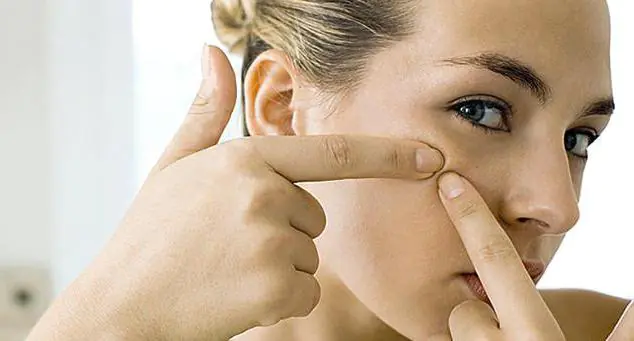
So, let's look at what causes acne on the face:
- excess subcutaneous fat;
- hereditary predisposition;
- poor nutrition;
- stress;
- a lot of dead cells under the skin;
- skin damage;
- inflammation;
- poor facial skin care;
- menstrual cycle;
- lipid metabolism is disturbed;
- the stratum corneum of the skin is enlarged;
- diseases of the stomach and intestines;
- impaired immunity;
- exposure to harmful microorganisms;
- improper use of cosmetics;
- working with toxic substances;
- climate impact;
- excessive cleanliness;
- medicines.
Foods that cause acne
All the reasons listed above are not a complete list of what causes pimples and acne on the face. Sometimes they appear suddenly. Common products that can help with this include:
- Coffee. It should not be drunk on an empty stomach.
- Animal fats. It is better to replace them with vegetable ones.
- Nuts. You should not eat a lot of walnuts, pistachios and almonds.
- Dairy products. It's better to eat low-fat ones. Eat less cheese and ice cream.
- Sweets (candy, sugar, soda, chocolate, etc.).
- Flour products, especially cakes, chips, cookies.
How to choose treatment?
For effective treatment it is necessary to assess the severity of the disease. You can photograph all areas of the skin where pimples, blackheads and blackheads are visible. They determine the degree of the disease. Black dots need to be counted and compared with the scale:
- mild – less than 10 (grade I);
- average – 10-25 (II degree);
- heavy – 26-50 (III degree);
- very severe - over 50 (IV degree).
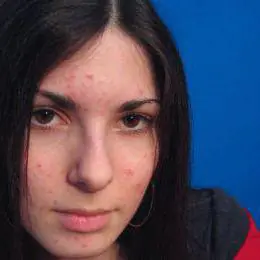
Already formed inflammations (pimples and blackheads) are also calculated in order of increasing degree:
- 1st degree – less than 10;
- 2 tbsp. – 10-20;
- 3 tbsp. – 21-30;
- 4 tbsp. – over 30.
Acne on the face
What causes acne on the face? On the forehead, such inflammations most often form due to the large production of sebum. This area of the face contains many sebaceous and sweat glands. Acne and pimples can appear due to diseases of the gallbladder, pancreas, intestines and stomach.
Inflammatory formations above the eyebrows indicate intestinal irritation. Pimples located closer to the hair indicate a malfunction of the gallbladder. The appearance of acne directly on the forehead means possible intoxication of the body as a whole. Acne on the chin indicates a disorder of the digestive or endocrine system.
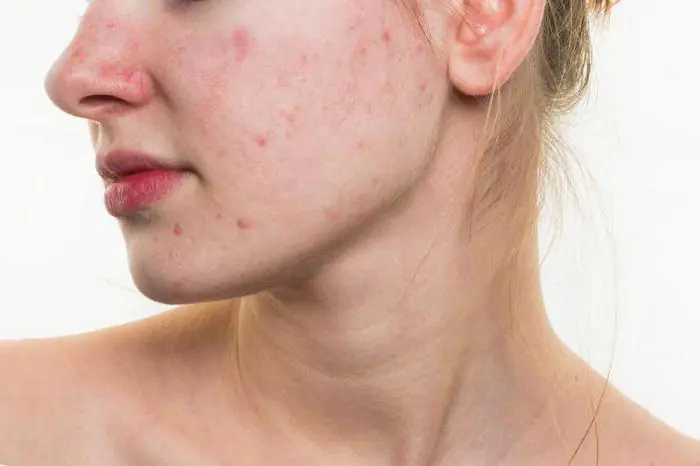
Pimples that appear on the nose occur due to hormonal imbalance. This is usually the teenage period. If this phenomenon is observed in an adult, the immune system, digestive or endocrine system may be impaired. pimples on the bridge of the nose are a consequence of liver overload and poor blood purification. Pimples appearing on the lips indicate a violation of the digestive system, and on the cheeks - an overload of the lungs.
Acne in children
Pimples often appear in babies. If they are white, you don't have to worry too much. This is most likely milia (blockage of the sebaceous glands). Such rashes go away on their own after a couple of months. Sometimes acne appears in a child due to allergic reactions. But they can also indicate diseases. Most often, acne in children appears as a result of measles, scarlet fever, rubella, and chickenpox.
Skin problems in adolescence
Acne on the face of a teenager most often appears as a result of puberty, since hormones are responsible for the functioning of the sebaceous glands. During this period, a large amount of secretion is produced. And this is a very favorable environment for the growth of bacteria. As a result of an increase in their numbers, inflammation manifests itself in the form of pimples and blackheads.
It is very difficult to treat them during this period, since the reason lies within the body itself. Please note that everyone's skin is different. This means that treatment is selected strictly individually. But there are some general tips:
- daily facial skin care;
- regular contrast washes twice a day (with hot water and then cold);
- use of facial scrubs;
- use of steam baths.

One of the best proven acne treatments is salicylic acid. You can use tar soap and mash. It is prepared in pharmacies according to a doctor's prescription. Apply in the evening with a cotton swab to the face. For external use, brewer's yeast is also good for getting rid of acne. During treatment, you must follow a diet: avoid carbonated drinks, spicy and fatty foods.
Acne in adults
Why do you get acne on your face at 30? Not only teenagers suffer from this problem, but adults can also experience inflammation of the subcutaneous tissues. There are several main reasons why adults also develop acne:
- Hormonal imbalance. In women, this often happens during menstruation or pregnancy.
- Diseases of the gastrointestinal tract.
- Hyperkeratosis (keratinization of the skin). Small “scales” appear. The sebaceous glands work very actively; waste and bacteria accumulate in their mouths. This is where acne and pimples form. This is a very serious and dangerous skin disease that is very life-threatening.
- Demodex mite. One of the most common reasons. Every person has this mite, but it is usually activated when the immune system is weakened. What causes pimples with pus on the face? This is just typical for demodex. Along with inflammation, a general redness of the skin is observed. The disease is treated by a dermatologist. At home, you need to change your bed linen more often.
- Stress.
- Poor hygiene.
- Cosmetical tools.
- Squeezing pimples. After removing one, a dozen new ones may appear.
After squeezing out pimples, wounds remain on the skin, in the treatment of which the cream with a bactericidal and wound-healing effect “ARGOSULFAN ®” has proven itself well. Unlike many antibacterial ointments that have long been familiar to us, to which microbes have developed resistance, it contains silver sulfathiazole, to which bacteria do not become accustomed. The active substance of the cream “ARGOSULFAN ®” has a wide spectrum of antibacterial action and promotes rapid healing of the wound without the formation of a rough scar.
There are contraindications. You need to read the instructions or consult a specialist.
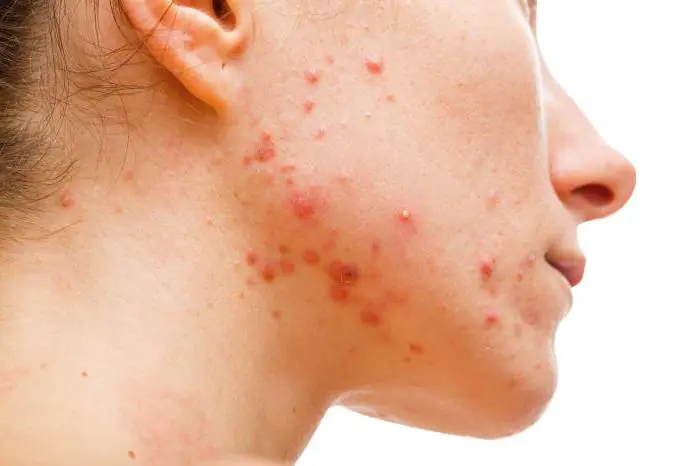
For treatment, it is necessary to correctly determine the cause of acne. But in any case, it is necessary to spend less time in the sun, maintain hygiene and diet, and also take vitamins.
Why do blackheads appear on the face?
What causes pimples and blackheads on the face? Contaminated skin and poor skin care are often to blame for this. Especially if there is no daily cleansing. Poor quality cosmetics are another cause of blackheads and pimples. There are several more reasons:
- deterioration of health;
- hormonal imbalance.
How to destroy acne?
Acne needs to be treated only comprehensively. This includes:
- constant facial cleansing;
- restoration of hormonal levels;
- restorative procedures for the skin;
- fight against pathologies and diseases that cause acne;
- face massage;
- masks;
- medicines;
- hardware therapy methods.
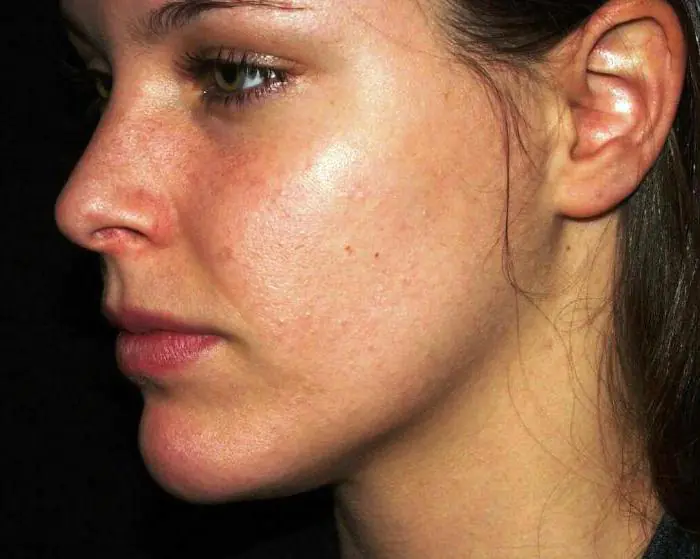
What causes acne on the face? They often occur due to poor nutrition. Therefore, it is even more important to follow a diet during treatment. Especially if you are getting rid of acne. It is necessary to exclude protein-enriched, fatty, spicy and salty foods. As well as chips, carbonated and alcoholic drinks, flavored teas, and sweets. You should give preference to fish, cereals, poultry, vegetables and fruits.
Treatment of acne with green tea
Green tea helps effectively fight acne. It is a good antioxidant and antibacterial agent. Green tea can be used as an herbal supplement or made into a cream. After brewing, the leaves are applied to the face like a mask. But first, the face must be thoroughly cleansed and rinsed with water. In China, to kill acne, green tea is drunk with honeysuckle, but without sugar, as it neutralizes the healing effect.
Treatment of acne with folk remedies
You can try to cure acne on your own. There are folk remedies that people have used since ancient times. All of them are used after preparation in the form of lotions.
- from the leaves of aloe vera;
- calendula with honey;
- from sage leaves.
- St. John's wort;
- from birch buds.
Medicines to treat acne
What causes acne on the face? Whatever the cause of their occurrence, this is subcutaneous inflammation. Since ancient times, acne has been treated with extracts of witch hazel and chamomile. Triclosan, salicylic acid, zinc oxide and vitamins A, B, C help well. When using these drugs, the layer of sebum decreases, as does the process of inflammation in the follicle and skin. All of these drugs have an antibacterial effect. Pharmaceutical products for acne are divided into two groups: for external and internal use.
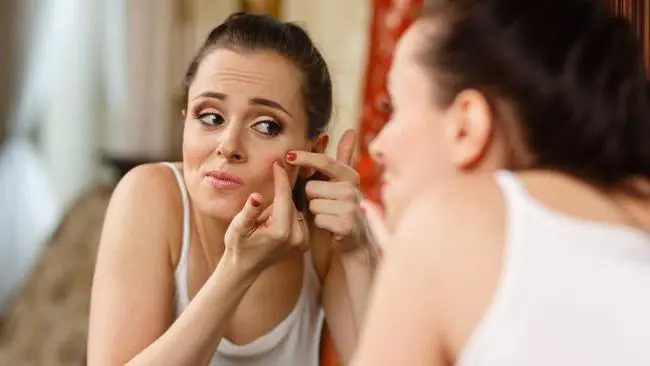
For external use:
- Retinoids that target the cause of acne. Suppresses the growth of skin cells, prevents and reduces clogging of pores.
- Antibacterial agents act specifically on bacteria. These drugs include antiseptics and antibiotics.
- Azelaic acid agents inhibit cell division. And this ensures the patency of the excretory skin ducts. These drugs have antibacterial properties. Azelaic acid is found in Aknestop cream and Skinoren gel.
How to deal with acne?
After the appearance of rashes on the skin, the question arises: “What causes acne on the face and how to deal with it?” You can try cosmetics, for example:
- Antibacterial soap. But you cannot use it constantly, but only from time to time.
- Cleansing gels regulate the formation of sebum.
- Anti-aging emulsions-creams prevent micro-inflammations.
- Normalizing gels. Antibacterial agents moisturize the skin and remove excess oil.
- Masking pencils. They have an antibacterial effect and dry out acne. Apply at the first stage of inflammation.
- Moisturizing emulsions prevent acne and moisturize the skin.
Device therapy uses several technologies. For example, a complex pulse consisting of a radio frequency range and a light spectrum. When it hits an inflamed area, the impulse affects the cause of acne. There are other technologies.
What causes acne on the face? You need to pay closer attention to your skin. Perhaps the pores are clogged, there are a lot of dead cells, etc. This can be corrected with chemical peeling, which removes a large layer of the epidermis. This uses glycolic and salicylic acid. To combat acne, superficial peeling is also performed. Laser therapy is sometimes used.
Subcutaneous acne on the face causes a lot of inconvenience and discomfort in aesthetic terms. But you should worry not only about this, because they are a consequence of the inflammatory process that has arisen in the sebaceous glands against the background of purulent concentration in the subcutaneous tissues (or exudate). Such conditions are an excellent environment for the intensive proliferation of bacteria. In serious cases, this process is accompanied by cystic formations.
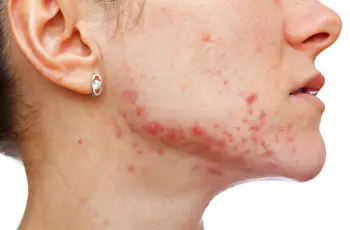
Causes and mechanism of formation of internal pimple on the face.
Subcutaneous acne is not only a problem for young people (about 80%), they can also appear in adults (40%). The main reason for the appearance of subcutaneous acne is the inflammatory process in the sebaceous ducts, which are located deep in the skin. This is due to an increase in the level of androgens (male sex hormones) in the body, as a result of which there is excessive production of sebum, which, in turn, accumulates in the excretory sebaceous ducts and attracts bacteria that feed on this sebum and multiply intensively. Against this background, inflammation develops. The keratinized layer of epithelium or dead surface skin cells clog the outlet of the sebaceous glands, and continued inflammation and infection of the affected area leads to the appearance of a reddish, hard-to-touch lump, which we call a subcutaneous pimple. Other factors can provoke inflammation of the ducts of the sebaceous glands and, as a result, the occurrence of subcutaneous acne.
Factors that provoke the appearance of subcutaneous acne.
- Hormonal imbalance due to puberty, menopause, pregnancy and lactation, taking hormonal contraceptives and medications, the presence of sexually transmitted and neuroendocrine diseases.
- Disorders of the sebaceous glands.
- Dermatological diseases.
- Insufficient or improper skin care.
- Abuse of peelings.
- Unhealthy diet with excess fatty, sugary, sugary foods.
- Violation of cell immunity.
- Genetics.
- Subcutaneous mite (Demodex).
Symptoms and signs of subcutaneous pimple.
The formation of a subcutaneous purulent pustule externally manifests itself in the form of a small hard growth of a reddish or white color, rising above the surface of the skin. As the compaction matures, a bright red tubercle appears, upon pressing which a painful sensation occurs. The size of a red subcutaneous pimple can range from 1-2 mm to 1 cm or more.
Often, with large purulent accumulations, acne growth increases. In advanced cases, large nodes make the skin lumpy with an unhealthy reddish tint. Such formations are localized mainly in areas most susceptible to the development of the inflammatory process (face, chest, back, neck, shoulders, arms).
Red subcutaneous pimples may not form purulent pustules for a long time, accompanied by unpleasant itching and pain when pressed.
If the cause of acne on the face is a subcutaneous mite, then the bright red subcutaneous lumps have multiple distributions and are accompanied by severe itching and flaking of the skin.
The success of treating subcutaneous pimples (acne, acne) depends on the correct identification and elimination of the cause that provoked their appearance.
Consequences for the skin.
Subcutaneous acne affects the external attractiveness of the skin, adding to its owners a lot of complexes about this. In addition, if treated incorrectly, they can leave spots and scars behind (post-acne).
Never squeeze pimples! This leads to the spread of bacteria and acne damage to new areas of the skin, and sometimes blood poisoning, because when squeezed out, the purulent contents directly enter the blood vessels, spreading it throughout the body. By the way, any type of cosmetic skin cleansing is also prohibited, because the procedure itself is nothing more than squeezing out pimples.
Treatment of subcutaneous acne on the face.
Treatment of subcutaneous acne depends on the degree of skin damage. If there are up to 10 such elements on the face (mild degree or first stage), treatment should be exclusively external. In this case, it is necessary to use cosmetics whose action is aimed at reducing sebum, fighting microbes, and eliminating hyperkeratosis. These products include cleansers and mattifying agents (gels, tonics). To treat acne, external gel Differin is effective. Any medications and cosmetics should be selected by a dermatologist and cosmetologist.
The average degree of acne damage to the skin (or the second stage) is when you have from 10 to 40 elements on your face. At this degree of development of acne, internal and external treatment is indicated. External treatment consists of using the same external agents as for mild lesions. But for internal treatment, the doctor individually selects hormonal contraceptives, one of the directions of which is the fight against moderate or moderate acne (pimples or acne). The contraceptive also reduces the level of male sex hormones. Additionally, an antibiotic is prescribed orally (for example, Doxycycline), which should be taken for three months. This is due to the fact that the skin renewal process occurs once every 28 days. Three skin renewals must take place in order for the face to become clean and smooth.
The third degree of skin damage (or third stage) - when there are more than 40 elements on the face, almost the entire face is covered with acne. In this case, the treatment is more serious. The drug retinoic acid (derivatives) is prescribed orally. The only such drug is Roaccutane. There is no external treatment for this degree of skin damage. The drug blocks the release of sebum from the sebaceous glands, depriving microbes of “food”, causing drying of the skin. The drug should be prescribed exclusively by a medical specialist; it gives an effective result.
Methods of treatment and elimination and consequences of acne on the face.
- Microdermabrasion - perfectly removes dead layers of epithelium, increases blood circulation, improves regeneration and recovery processes.
- Acid peeling – cleanses the skin of dead skin cells, accelerates tissue regeneration, and increases skin elasticity.
- Laser resurfacing – removes dead skin cells using a laser beam, the procedure improves tissue metabolism and accelerates their recovery.
- Physiotherapeutic and hardware methods for the treatment of subcutaneous acne (applicable only for mild to moderate lesions).
- Phototherapy – accelerates regeneration processes in cells.
- Ozone therapy - eliminates swelling and inflammation, eliminates pathogenic microbes, reduces pain, stimulates the production of collagen and elastin fibers through exposure to oxygen.
- Elos therapy - exposure to inflamed areas with blue light pulses.
- Mesotherapy – elimination of inflammation and restoration of the skin.
Home methods for treating subcutaneous acne on the face (relevant for mild skin lesions).
Before cleansing the skin, it is effective to take steam baths based on infusions or decoctions of chamomile, celandine, calendula, mint, and sage. Herbal decoctions are also good to use for daily washes or lotions (wipe the skin several times a day). To prepare an infusion of herbs, take a tablespoon of the raw material, pour 200 ml of boiling water and leave for half an hour, strain. To prepare the decoction, do everything the same as for the infusion, only the brewed herb should be additionally simmered over low heat for five minutes, then allowed to cool and strain.
Tea tree oil is a powerful natural antibiotic. It can be applied directly to pimples several times a day.
You can apply iodine to single pimples, do it quickly and carefully, literally touch it with a cotton swab. It is important to be careful here, otherwise you may get a skin burn.
Ichthyol ointment (Vishnevsky ointment) perfectly draws purulent exudate out and lubricates pimples.
Synthomycin emulsion mixed with warm boiled water (1:1) serves as a good tonic (wipe twice a day) that accelerates the healing process.
Tar soap has an excellent antibacterial effect; use it instead of cleansers.
Aloe will help speed up the release of pus from a pimple; it is recommended to cut a fresh leaf in half and apply it to the pimples overnight, securing it with a band-aid. In two days the pus will come out.
For mild skin lesions, it is good to lubricate pimples with calendula tincture in alcohol (can be bought at a pharmacy).
Aspirin also relieves inflammation well, improving skin condition. To do this, apply a mixture of aspirin and water to the spots twice a week (crush the tablet into dust and mix with water to form a paste-like mixture). There is no need to rinse off the mixture.
A decoction of birch buds helps reduce inflammation and pain from red internal pimples. For the decoction, you need to brew 10 g of buds with 250 ml of boiling water, put it on the stove over low heat, after five minutes, remove it and, having wrapped it well, let it brew for three hours, strain. Use daily, rubbing the skin, and additionally apply lotions to inflamed areas two to three times a day.
Homemade mask recipes for internal acne.
Anti-acne masks will also help cleanse the skin, reduce inflammation, and dry out acne.
Clay mask.
Ingredients.
Talc powder – 10 g.
Clay powder (white or blue) – 10 g.
Milk at room temperature – 60 ml.
Application.
Combine the ingredients to a homogeneous paste-like mass, which is spread on the skin and left for twenty minutes. Rinse off the mask with room temperature water.
Clay mask with lemon and calendula tincture.
Ingredients.
Cosmetic clay powder – 3 tbsp. l.
Alcohol tincture of calendula – 20 ml.
Lemon juice – 15 ml.
Application.
Dilute the clay with tincture, add lemon juice. Distribute the composition onto the affected areas and leave for about twenty minutes. Rinse off with water at room temperature.
Clay mask with yeast.
Ingredients.
Cosmetic white clay powder – 10 g.
Yeast in granules - 10 g.
Warm milk.
Honey – ½ tsp.
Application.
Combine the dry ingredients and add milk so that a mass is formed that resembles thin sour cream, into which then pour liquid honey (if there is no individual intolerance). Spread the mixture onto the skin and leave for twenty minutes. Wash off the mask with warm water.
Prevention of subcutaneous acne.
To speed up the treatment process, as well as to prevent the appearance of acne, it is necessary to lead a healthy lifestyle, eat a healthy and balanced diet, eliminate bad habits, including nutrition, take walks in the fresh air, and play sports.
Periodically use herbal infusions (chamomile, calendula, celandine, etc.) to cleanse and tone the skin.
During the treatment of subcutaneous acne, it is recommended to refrain from using decorative cosmetics, especially foundation and dense powder, they clog the pores, preventing the outflow of sebum. For excessively oily skin prone to rashes, these products are generally contraindicated.
There is no self-medication; all medications and drugs should be prescribed and selected only by a doctor.
Acne on the face or various parts of the body is often a consequence of internal disorders that arise due to errors in lifestyle, exposure to adverse factors or developing diseases. One of these problems is subcutaneous formations, which are not just an unpleasant aesthetic defect, but also a possible symptom of pathological processes occurring in the body.
What are subcutaneous acne
The process of formation of subcutaneous skin is directly related to the excessive production of sebum, which accumulates in the sebaceous ducts. It is a breeding ground for bacteria that multiply inside the sebaceous glands and provoke subcutaneous inflammation. As a result of the inflammatory process, a hard ball (bump) appears on the skin, which hurts when pressed and, unlike skin rashes such as pimples or acne, is not squeezed out in the usual way.
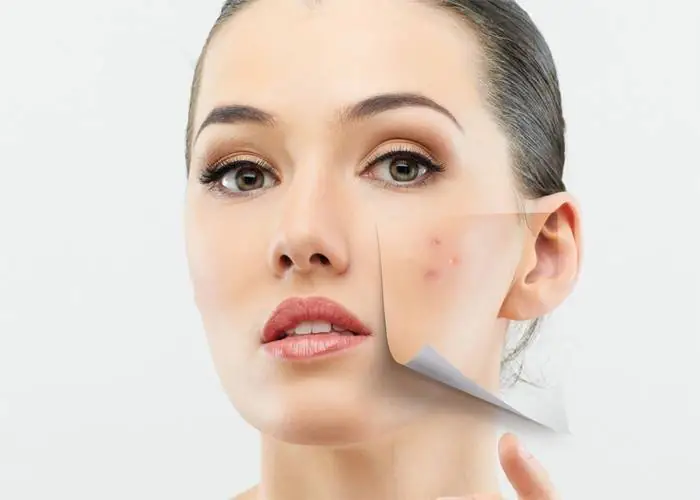
Inflammation affects the inner layers of the skin, and its superficial keratinized layer creates an obstacle to the normal cleaning of the sebaceous ducts. For this reason, it is difficult to get rid of subcutaneous acne, whether it is small white rashes or one large inflamed subcutaneous area. Such formations are located in the deep layers of the skin and “ripe” for a very long time, and therefore it is impossible to remove accumulations of sebum and pus from them using conventional methods.
Reasons for appearance
Having understood what subcutaneous acne is and what is the mechanism of its formation, it is necessary to find out what causes it. The main reason for the appearance of such rashes is a disruption in the process of sebum secretion, and it develops under the influence of a number of internal pathologies or external adverse influences. Why do subcutaneous lesions appear? Experts name the following factors that contribute to or provoke their formation:
- improper or insufficient skin care;
- hormonal imbalance associated with puberty, pregnancy, contraceptives, or endocrine diseases;
- overheating or hypothermia of the body;
- poor nutrition;
- abuse of peeling or tanning;
- disturbances in the gastrointestinal tract;
- reduced immunity;
- metabolic disease;
- hereditary predisposition;
- gynecological diseases;
- subcutaneous mite;
- bad habits (tobacco use, alcohol use).
On the face
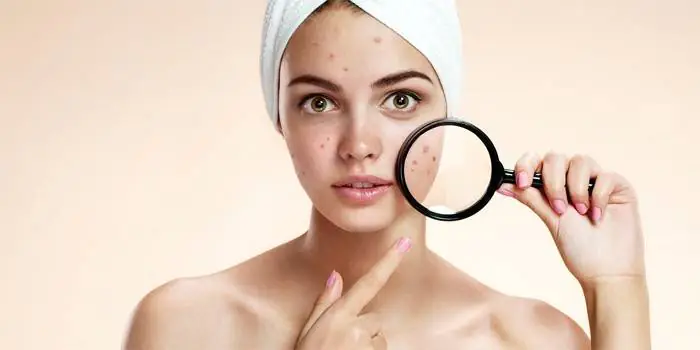
Problems with facial skin, manifested in the form of subcutaneous acne, often indicate hormonal imbalances in the body:
- If small bumps appear on the face that do not go away for a long time, this may be a consequence of developing endocrine pathologies or temporary hormonal imbalance due to natural causes (adolescence, pregnancy).
- In women, white pimples on the face can occur due to ovarian dysfunction caused by polycystic disease. In this case, they are localized on the chin and on the lower cheeks.
- In people with oily or thick skin, internal acne on the face appears due to excessive sebum production and can be located anywhere - on the forehead, nose, cheekbones, chin.
- Painful lumps on the lips that initially look like pimples may be a sign of herpes.
On the back
The appearance of subcutaneous lesions on the back can also be a consequence of sudden hormonal changes, but this phenomenon is often observed in athletes or people leading an active lifestyle. During physical activity, the back constantly sweats, and this contributes to the contamination of the sebaceous ducts and the accumulation of sebum in them, leading to the development of the inflammatory process and the appearance of acne. Find out how to remove acne on a woman's back.
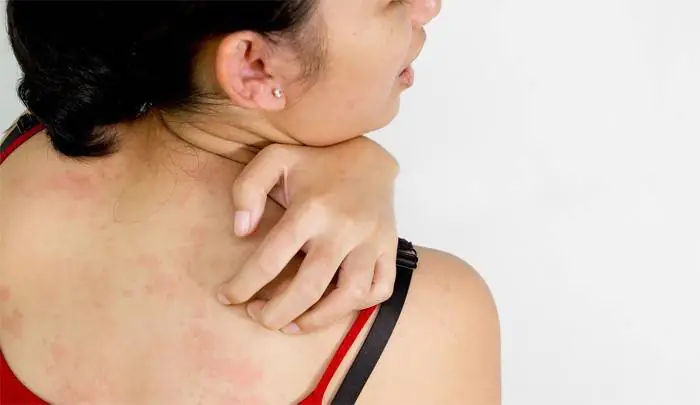
On the neck
Rashes on the neck, located in the deep layers of the epidermis, rarely occur, since the skin in this part of the body is thin. If such pimples appear in this area, it is recommended to undergo a comprehensive medical examination, since they may be associated with diseases of the internal organs or the beginning of the development of pathological processes in the body.
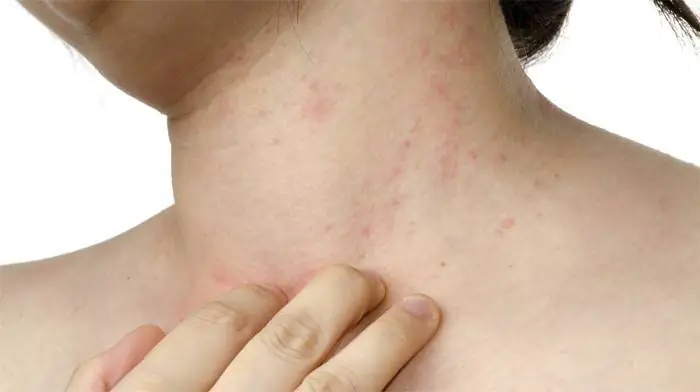
On hands
The appearance of subcutaneous rashes on the hands may indicate endocrine disorders, allergies, and hereditary diseases. If acne appears below the elbow or in the area of the hands, this should be especially alarming, because in these areas there are fewer sebaceous glands and the appearance of skin formations on them can indicate serious pathologies and malfunctions of the body.

On the labia
Subcutaneous formations in the genital area in many cases occur due to hypothermia of the body. They may appear after a cold, swimming in cold water or improper hardening. Other possible causes are microtraumas that occur during hair removal in the bikini area, as well as wearing synthetic underwear, which irritates the skin and causes it to overheat.
Subcutaneous bumps all over the body
If subcutaneous rashes are located throughout the body, this may be a manifestation of a genetic disease - hereditary lipomatosis. With this disease, bumps can appear on any part of the body - neck, arms, legs, stomach, back. This disorder requires careful examination and long-term complex therapy, and sometimes surgical intervention.
How to get rid of internal pimple
If there are a lot of subcutaneous formations and they do not go away for a long time, it is unlikely that you will be able to get rid of them on your own. In such cases, consultation with a dermatologist and special therapy are necessary. The same applies to such an unpleasant manifestation as acne on the face located deep under the skin, the treatment of which must be carried out under the supervision of a specialist.
However, if the pimple is single and has appeared recently, you can try to remove it without seeking medical help by using available pharmacy and home remedies. How to remove the subcutaneous tissue? Such pimples “mature” for a long time, over several weeks, so attempts to squeeze them out will be unsuccessful. How to treat the skin to speed up this process and prevent complications from developing?
Ointment
An excellent remedy for combating subcutaneous skin are Vishnevsky ointment, Levomekol, and zinc ointment. How to pull out a pimple using these drugs? Ointments should be applied to the affected areas at least 2 times a day. In addition, compresses made from ichthyol ointment have a good effect, drawing the contents of the subcutaneous tissue out. It is recommended to apply them at night.
Cream for subcutaneous acne
When treating subcutaneous rashes, creams with an antibacterial and healing effect are helpful, allowing you to quickly stop the inflammatory process and accelerate tissue regeneration in the affected area. The most effective products in this category, recommended for the fight against subcutaneous skin, are the creams “Baziron”, “Differin”, “Skinoren”, “Klenzit-S”.
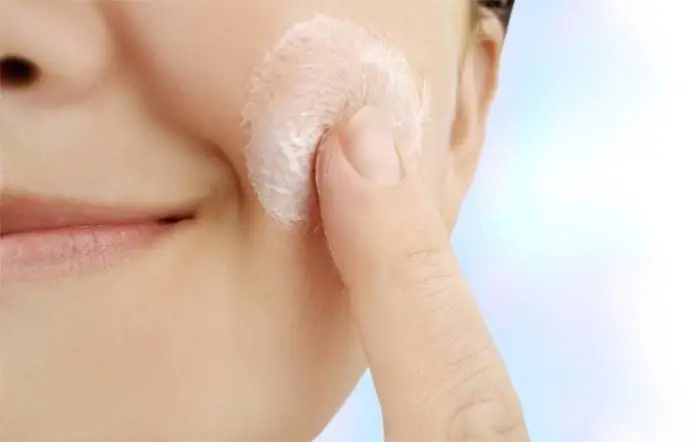
Treatment with folk remedies
Simple folk recipes that are available for use at home will help eliminate subcutaneous formations:
- Aloe compress. It helps well to get rid of such an unpleasant phenomenon as a long-lasting purulent pimple that cannot burst on its own. Cut an aloe leaf, apply it to the site of inflammation and secure with a bandage. It is most convenient to apply the compress at night.
- Tea tree oil. Apply it to your pimples every 3-4 hours for a few days until you notice improvement.
- Mask of oil and garlic. Lubricate the problem area with vegetable oil, and then precisely apply chopped garlic to the area of inflammation and place gauze soaked in hot water over it. Leave on for 20 minutes and rinse off.
How to squeeze a pimple
When deciding to squeeze out a pimple located deep under the skin, it is very important to remember the high risk of infection, even wider spread of rashes or scarring on the skin. A fully mature pimple can be squeezed out after first disinfecting your hands and treating the wound with an antibacterial solution. However, the removal of multiple formations must be entrusted to a dermatologist or cosmetologist.
Video: how to cure an internal pimple
Once and for all, special video materials will help you deal with the problem of subcutaneous rashes, in which this topic is covered in as much detail as possible. Experts talk about the main reasons for the appearance of such formations, provide photos of common types of rashes, explain how to deal with them and how to properly remove a pimple located in the deep layers of the epidermis.



